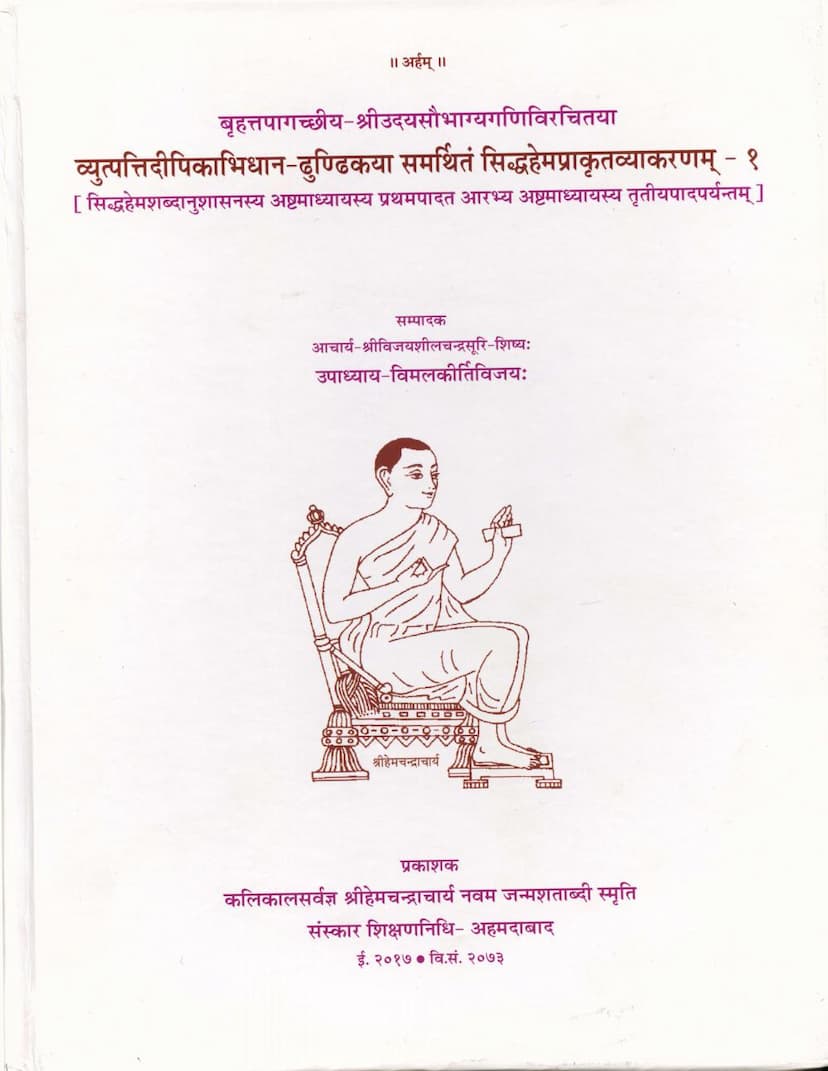Vyutpatti Dipikabhidhan Dhundikaya Samarthitam Siddha Hem Prakrit Vyakaranam Part 01
Added to library: September 2, 2025

Summary
The provided text is the first part (Volume 1) of the "Siddha Hema Prakrit Vyakaranam" (Siddha Hema Prakrit Grammar), a significant Jain text. The title itself indicates that it is a grammar of Prakrit language, based on the foundational work "Siddha Hema Shabdanushasana" by Acharya Hemchandracharya.
Here's a comprehensive summary of the content, focusing on the provided pages of Part 01, which covers sections of the 8th Adhyaya (Chapter) of Hemchandracharya's work:
Overall Context:
- Title: Vyutpatti Dipikabhidhan Dhundikaya Samarthitam Siddha Hem Prakrit Vyakaranam Part 01
- Author: Vimalkirtivijay (Editor)
- Publisher: Kalikal Sarvagya Shri Hemchandracharya Navam Janmashatabdi Smruti Sanskar Shikshannidhi, Ahmedabad.
- Date: 2017 CE / 2073 VS.
- Content: This volume specifically deals with the 8th Adhyaya (Chapter) of the Prakrit section of Hemchandracharya's Siddha Hema Shabdanushasana, starting from the first pada (section) and continuing up to the third pada. This means it focuses on the grammatical rules and transformations specific to the Prakrit language, as elaborated by Hemchandracharya.
Key Features and Content Summary:
-
Commentary and Support: The title "Vyutpatti Dipikabhidhan Dhundikaya Samarthitam" indicates that this work is a commentary or elucidation (Dipika) on the grammatical principles (Vyutpatti) of Prakrit, supported by a specific tradition or viewpoint referred to as "Dhundikaya," attributed to Shri Udayasaubhagya Ganivara. This suggests a lineage of scholars who followed and explained Hemchandracharya's original grammar.
-
Focus on Prakrit Grammar: The text is a detailed examination of Prakrit grammar, a language known for its prevalence in Jain scriptures and literature. Hemchandracharya's original work was monumental for its comprehensive coverage of both Sanskrit and Prakrit grammar. This volume specifically delves into the Prakrit part.
-
Detailed Rules and Examples: The content is structured around specific grammatical rules, likely following the Sutras (aphorisms) of Hemchandracharya's original work. Each rule is presented with explanations and numerous examples (Udaharanas) and counter-examples (Pratyudas). The text extensively uses Sanskrit terminology for grammatical analysis.
-
Specific Grammatical Topics Covered (from the provided text's initial pages):
- Page 14-28: This section appears to cover rules related to sandhi (joining of sounds) in Prakrit. This includes rules about vowels and consonants, their interactions, and optional or mandatory changes when words are joined. It seems to be discussing phonological rules like:
- The use of Sanskrit nature of Prakrit ("Prakritam prakritih = Sanskritam, tatra bhavam").
- The exclusion of certain Sanskrit sounds (like R, L, Vr, H, Visarga, Pluta).
- Assimilation of consonants (e.g., ङ-jau svavargasamyuktau).
- Changes in vowels like ऐ (Ai) and औ (Au).
- The concept of "Bahulam" (variety or irregularity in rules), which is common in Sanskrit and Prakrit grammars.
- "Arsham" (related to Rishis or ancient texts) and its application to grammatical rules, indicating influence or usage found in ancient Prakrit literature.
- Rules regarding vowel changes in compounds (samasa) or at word boundaries, often with optional variations (e.g., Dirgha-hrasva Mithah vrttau - long and short vowels interchanging in compounds).
- The concept of "Padayoh Sandhirva" (sandhi between words is optional).
- Rules about specific consonants and their interactions, like those involving Y, J, G, N, etc. (e.g., "Nuvarnasyasve", "Etadoh sware").
- The text goes into great detail about how specific Sanskrit words are transformed into their Prakrit equivalents, citing numerous examples from literature.
- Page 14-28: This section appears to cover rules related to sandhi (joining of sounds) in Prakrit. This includes rules about vowels and consonants, their interactions, and optional or mandatory changes when words are joined. It seems to be discussing phonological rules like:
-
Editorial and Scholarly Value:
- The publication by the "Kalikal Sarvagya Shri Hemchandracharya Navam Janmashatabdi Smruti Sanskar Shikshannidhi - Ahmedabad" highlights the text's importance in commemorating the 900th birth anniversary of Acharya Hemchandracharya.
- The editor, Upadhyay Vimalkirtivijay, a disciple of Acharya Shri Vijayshilchandra Suri, is credited with the painstaking work of transcribing and editing the text from various manuscripts.
- The "Prakashakiy Nivedan" (Publisher's Note) and "Sampadakiya Nivedan" (Editorial Note) provide valuable context about the trust's mission to promote Jain literature, honor scholars, organize seminars, and publish ancient texts.
- The editorial note also touches upon the history of the Siddha Hema Vyakaranam and its influence, mentioning the use of examples from various literary works (like Chaturvimsati Stava, Vairagya Shataka, Dashavaikalika, etc.) and referencing the work of scholars like Muni Nyayavijaya, Dr. Weber, Dr. Kulkarni, and Dr. Harivallabh Bhayani.
- The mention of previously published seven parts of an unknown "Kundhikarana" commentary on the Siddha Hema Prakrit Adhyaya suggests a broader project of bringing lost or rare Jain grammatical works to light.
In essence, this volume is a scholarly edition and commentary of the Prakrit grammatical rules found in the 8th chapter of Hemchandracharya's magnum opus, providing detailed explanations and linguistic examples crucial for understanding the nuances of the Prakrit language. It serves as a valuable resource for students and researchers of Jainology and historical linguistics.